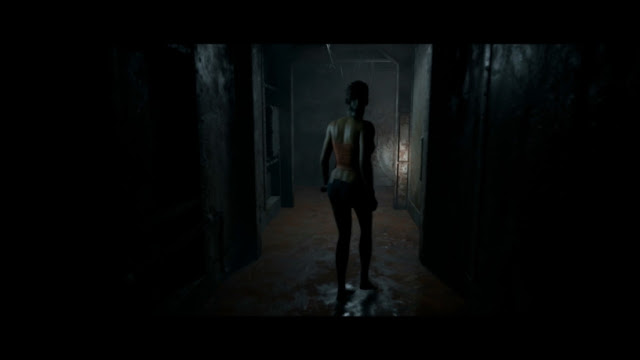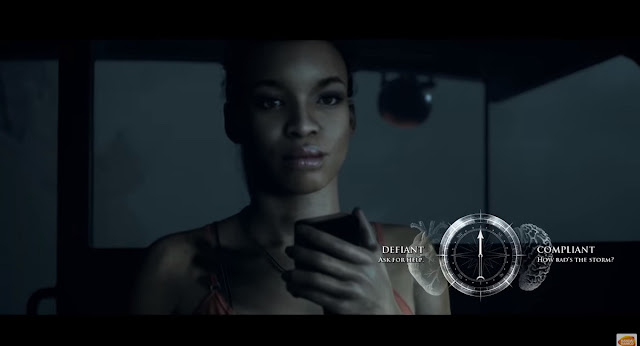Review by Matt S.
A decrepit old haunted ship in the middle of the ocean is one of the most well-worn environment settings in horror history. Ever since the rumours of the Flying Dutchman spellbound audiences centuries ago, the ghost ship has been an easy go-to for horror storytellers, so it makes sense that Supermassive Games would use that exact setting for the first in its planned anthology of horror – Man of Medan.
It’s not hard to figure out why ghost ships make for such an effective horror setting. Opportunities for escape are limited, and the writers don’t even need to come up with some contrivance to explain why the protagonists are trapped in a specific space – that’s nearly provided through the environment itself. Furthermore, ships are dominated by cramped, claustrophobic corridors and rooms, making them ideal for intense encounters and jump scares.
Man of Medan’s greatest strength is its cinematic treatment of its environment. The development team have worked hard to nail down every camera angle, in every scene, to have maximum dramatic impact. My favourite through the entire game was one moment where your characters are descending a set of stairs, and the camera slowly tracks them from behind the stairs – like looking at the characters through Venetian blinds, your view is half obscured by the black bars across the screen. Thankfully Man of Medan isn’t an action-orientated game, else these camera angles would detract from the playability, but the voyeuristic intimacy of so many of these camera angles demonstrate just how closely the development team studied the horror filmmaker’s tools of the trade.
As a narrative experience, Man of Medan isn’t subversive and doesn’t push boundaries, though that’s not an issue because if it had that would have been at odds with what Supermassive Games is trying to achieve. As the first of an “anthology,” Supermassive Games has been out there telling people that each title will take a trope or subgenre of horror and explore it through the same gameplay lens. As this is the first of the series it’s hard to tell how effective the overall anthology will be, but it’s going to be interesting to see the (hopefully) subtle shifts in design, pacing, characterisation and narrative tones that represent the various horror genres. We don’t know what will come after Man of Medan at this stage, but there’s so many directions Supermassive could go – sexploitation, psychological thriller, gothic horror, splatter, erotic thriller – there is every chance that the series as a complete package could be a wonderful deconstruction on horror, showing players how various horror sub-genres are different to one another, by giving players a common frame of reference across them all, in the gameplay structure.
That’s thinking ahead, though, and we’re here to talk about Man of Medan. Man of Medan is about five friends out for a cruise who find themselves kidnapped by a bunch of pirates, and imprisoned on a seemingly abandoned cargo ship… but one that’s filled with bodies, so everyone knows that something really bad happened here. Your task from there is to try and get all five of them off the ship alive. It is possible to save them all… but it’s also entirely possible that they might all die.
The bulk of what determines who lives, and who dies, will be the moral decisions that you make along the way. Periodically a little pop-up window will show on the screen, giving you a couple of different decisions to make. What’s great about Man of Medan is that these decisions never really project the consequences – they’re far more subtle and organic in how they effect the story, and so for the first play through you’re really encouraged to let your conscience guide you. For me, it didn’t go so well, but because I didn’t feel like I could predict what would happen and “game” the system, I also felt a great deal of satisfaction in the overall experience that it was reflective of my choices.
The other elements of the gameplay are not implemented so well. Characters control like the “tank controls” of horror titles of yesteryear, but it’s something that really lets the atmosphere down. Nothing kills tense immersion quite like struggling to get a character to move in the right direction… and then watch them walk directly into a wall or other obstacle. Thankfully there are no action sequences where you have direct control, but when those occur, you’ll have quick time events come in instead… and often those happen without warning. I’ll admit that more than a few times I failed a QTE because I was only holding the controller in one hand, or had put it down on the table. Man of Medan is meant to be all about the narrative, after all. Asking players to be in perpetual readiness for some quick button action is a little at odds with the rest of the game’s design.
These issues are secondary to the atmosphere and narrative of Man of Medan, however. Much like Until Dawn before it, Supermassive Games understands how to run a slow build with some explosive payoffs, and the tension in waiting for the real horror to kick in is exquisite. At first I was a little surprised that the narrative would reveal the nature of the monster in the very first act (the opening chapter shows players exactly what happens to the ship to render it a ghost ship), but as I played on I realised why that was the case – in knowing what is going to show up at some point, you start to wonder when it will come. That way, any time you visit a new area, or have characters split up, you spend the rest of the scene waiting for something awful to happen to them… and I actually found myself avoiding certain things (like closely checking a coffin an area), because I already had a sense of what was going on there. Replaying the mystery at the core of many horror titles (what is the nature of the monster), for perpetual tension leaves Man of Medan in a constant state of high tension, making the game feel more intense than its slow burn might have been were it depicted differently. Of course, there are some surprises and revelations along the way too, but this is a rare suspense title which isn’t really trying to throw players a “gotya” with twists that are as far fetched as they are unpredictable.
The ship has various paintings that you can discover and look at through the story, too, and each of these provide a small augury of what will come to pass later down the track. This, too, is giving away what may well kill characters (or at least the horrors that will happen to them), and thus the surprise and suspense of most horror, in exchange for an ongoing sense of expectation and general fear.
This approach makes sense when you consider that Man of Medan is designed to be played multiple times, encouraging players to track down every ending, and see if they can achieve the big challenge of getting every character out alive. This way, the atmosphere and intensity will persist on, even after you already know each major plot point. On a single run, it’s not an overly long experience, but were it any longer it would feel bloated. The team should be applauded for knowing the limits of what they are working on, and for the same reason that horror films are usually around half the length of an Avengers blockbuster, so too is Man of Medan a confidently brief experience.
My only other issue with Man of Medan applies to most of Supermassive Games’ work; the team’s motion capture work is stiff and artificial, and the face rendering is deeply flawed. Characters look great in stills, but the moment they start moving around, the stiff gait breaks the suspension of disbelief, and the way their mouths and heads move when talking reminds me more of a creepy puppet show than a rendering of real actors. The performances themselves are great, and I found each and every character to be an enjoyable one. It’s just that for an experience that is otherwise so cinematic and wordy, it’s odd that the art team would drop the ball with the character faces.
Supermassive Game’s high concept – an anthology of horror stories – is off to a great start with Man of Medan. We don’t get nearly enough horror that aims to be thoughtful like this. The challenge will be to make sure that each game in the series is different enough to reflect a different approach to horror, but things are off to a good start.
– Matt S.
Editor-in-Chief
Find me on Twitter: @digitallydownld
Please help keep DDNet running:
Become a Patreon!











